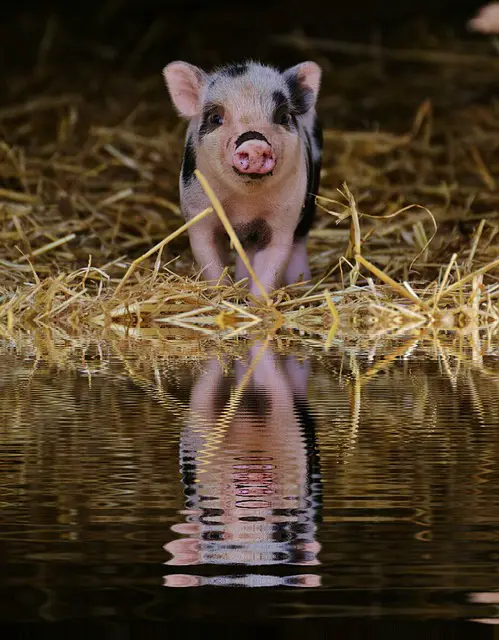Aside from food, water is critical in keeping your pig healthy as well. This is why it’s important to understand how to give your pig the water it needs.
What do pigs drink water from? Pigs can drink their water from automatic nipple waterers as well as in drink bowls. Choosing the right water system usually depends on how old your pig is and how much water it needs everyday.

50% to 70% of a pig’s body weight is just water. So you can imagine what kind of problems lack of water can bring.
What role does the water delivery system play in all of this?
Well, the way water is given to your pig can also decide whether the pig will drink enough water or not. Pigs have been known to get sick due to water deprivation simply because of the water system being used. As you read on, you’ll see what options you have and what systems would be best for your pig’s needs and preferences.
What Water Systems Can Pigs Drink From?
Your choice of water system may depend on a number of factors.
The number of pigs you have, for example, would be one thing to consider. Your pig’s age and size would also matter.
Here are some of the options that you have as far as water systems are concerned.
Automatic Pig Watering Systems
Automatic pig watering systems should be built differently than any other systems you may have for other animals you have. Pigs have very strong jaws, and if your drinkers aren’t strong enough, then your pig may have the ability to break it.
Ideally, this waterer should be made of metal so that they are durable enough to withstand environmental conditions as well. Keep the pipes buried underneath the ground. This saves you from the trouble of having to deal with frozen and bursting pipes when winter comes around. This would also ensure that the pipes aren’t directly exposed to the harsh heat during summer.
Simple Watering System
You also have the option of going for the simplest water system there is – a bucket!
Simply put the bucket in the middle of a tire, then fill it up with water. If your pig is big enough to topple this over, you can put a brick in the bucket to keep it sturdy.
You just have to make sure that the water in the bucket is always fresh. Clean the bucket regularly, too. Using a bucket or a bowl to let your pig drink is a potential source of illness, especially if you don’t clean it well.
Always check the bucket or bowl for any sign of biofilm. This is a film of dirt, both organic and inorganic, that can be a breeding ground for a lot of virus and bacteria. This can make your pig very sick.
Just run your finger along the bowl or bucket and check if you can feel any slime-like substance. If you do, then that needs to be cleaned right away. Of course, as much as possible, don’t wait for that dirt to build up before deciding to clean it up.
If you have a small piglet, be careful when using a bucket. Your piglet might fall into the bucket and drown, so make sure you use a bucket of appropriate size.
What Factors Affect Water Intake?
So you now know how to deliver water to your pig regularly. The next question is, how much water should your pig really be drinking?
First, let’s look at the different factors that affect your pig’s required water intake.
- Overall health
Sick pigs would normally require more water compared to healthy pigs. Especially if part of the pig’s symptoms are diarrhea and vomiting, you would have to make sure that your pig recovers whatever fluids it loses.
Fever would also require your pig to drink more water because the high body temperature would mean loss of water in the body.
- Diet
The amount of water your pig drinks may also rely on the kind of diet it has. For example, pigs that eat pellets seem to require more water than those who are given meals.
This is probably because of the difference in potassium and salt content in their food. The higher the salt and potassium content, the higher the demand for water.
- Temperature
The hotter it is, the more water your pig will need.
Your pig loses body heat the more they urinate. They don’t have the same sweat glands that we do, which means that they can’t perspire to cool down. This is their version of that cooling down process.
How Much Should My Pig Drink Everyday?
For your pig to stay healthy, this chart below shows how much water, on average, your pig should drink in a day.
Type of Pig
Nursery (0 to 60 lbs)
Grower (60 to 100 lbs)
Finisher (100 to 250 lbs)
Gestating Pigs
Lactating Pigs
Recommended Water Intake
0.7 to 1 gallon
2 to 3 gallons
3 to 5 gallons
3 to 6 gallons
5 to 7 gallons
This is the base requirement, but this can change depending on the factors given earlier. So if a 60-lb piglet is sick and is vomiting, it may need more than a gallon to make up for the loss of fluids.
Why Isn’t My Pig Drinking His Water?
Let’s stay you’ve provided a water system that you feel would fit your pig’s needs, but you notice that your pig still isn’t drinking as much water as it needs. In some cases, some pigs refuse to drink any water altogether.
There are a number of possible reasons why your pig is refusing to drink his water.
Water quality is one of the things that may be pushing your pig to refuse his drinking water. It’s possible that the water is contaminated, or may not be fresh enough for the pig’s taste.
You can try letting your pig drink water from a different source. If your pig drinks the new water you’re offering, then your original water source may be the issue.
Temperature could also be a potential issue. When the water is too hot or too cold, your pig may refuse to drink it.
You should also check how clean (or how dirty) your pig’s water bucket or bowl is. As discussed earlier, your pig may contract diseases from an untidy water bowl. Your pig may sense this threat and refuse the water.
Then of course, your pig simply may not like the taste of water. In this case, you can add some flavor to your pig’s water. Some pig owners add juice or Gatorade to their pig’s water. This isn’t really healthy though, as artificial sweeteners are bad for pigs.
A better idea would be to add treats like apples, cucumbers or watermelons to your pig’s water. These also have high water content, so if you don’t want to add it to your pig’s water, you can let them eat these as snacks.
Some may also advise you to soak your pig’s pellets in water to at least increase its fluid intake. Just make sure that soaked pellets are consumed right away, as there is a risk of molds growing in your pig’s food.
Related Questions
How long can a pig go without water?
When a pig spends 24 hours without water, the pig is automatically at risk of salt poisoning. This can make your pig very sick. This would also trigger the start of dehydration, which can lead to a number of more serious conditions, like nerve and muscle problems, as well as convulsions.
What do pigs eat?
Pigs usually eat pellets meant for their age, size and nutritional requirements, although some pig owners also choose to feed their pigs real meals. It all depends on your budget as well as the time you have in preparing your pig’s food. Pigs are omnivores, so they can eat both meat and plants. However, meat is usually discouraged because it’s easy to contract diseases from meat. Because of this, there may be a need to find protein supplements to satisfy your pig’s protein needs.

